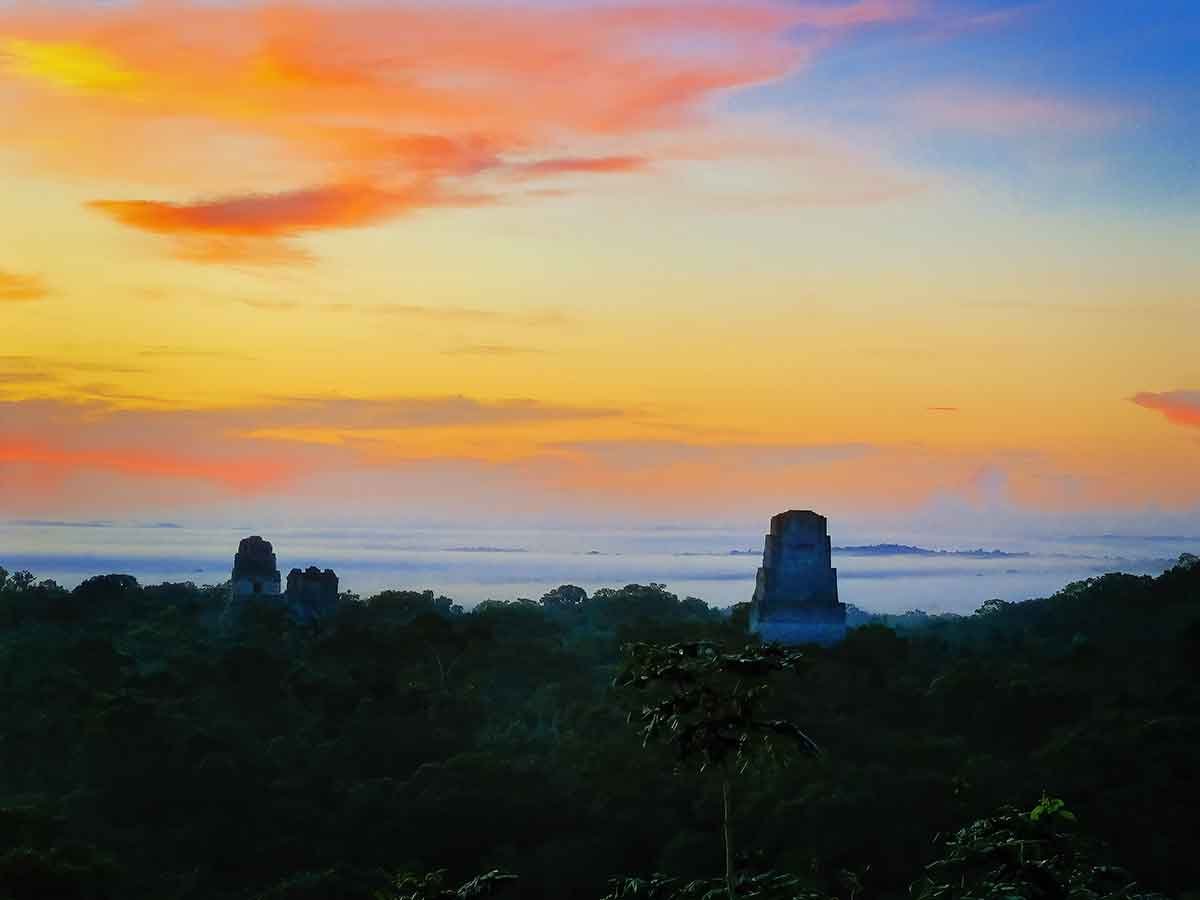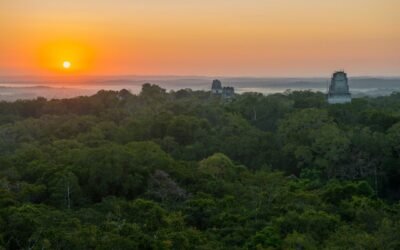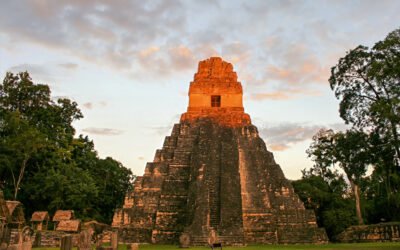Top Tikal structures to visit:
The Maya city of Tikal stands as a testament to the grandeur of ancient Maya civilization. Nestled within the Maya Biosphere Reserve, this archaeological site offers a unique perspective into the past. The attraction lies in its towering pyramids, intricate carvings, and expansive plazas. Each one of the top Tikal structures to visit has a rich history of the Maya culture that once thrived here. For those seeking Tikal Travel Information, these architectural wonders deserve a spot on every traveler’s bucket list. Whether planning Tikal Day Trips or delving into the History of Tikal, knowing What to Expect from a Day Tour of Tikal will enhance your experience of this magnificent site.
Top 10 Must-See Structures in Tikal
The Great Plaza
The Grand Plaza is the heart of Tikal. This expansive area showcases the architectural prowess of the Maya civilization. Due to its location and historical significance, visitors often start their exploration here.
Temple I (Temple of the Great Jaguar)
Historical Background
Temple I, the Temple of the Great Jaguar, is a monumental structure in Tikal. It was constructed during the reign of Jasaw Chan K’awiil I and dates back to approximately 732 AD. The temple served as both a tomb and a ceremonial site.
Architectural Features
Temple I’s design features steep stairways leading to a single room at the top. On the exterior, intricate carvings depict various deities and rulers. The temple rises about 154 feet above ground level, making it one of the tallest structures in Tikal.
Significance in Mayan Culture
Temple I is of immense cultural importance to the Maya people. It symbolizes power and religious devotion. The temple’s construction coincides with significant astronomical events, reflecting the advanced knowledge of Maya astronomers.
Temple II (Temple of the Masks)
Historical Background
The Temple II, or the Temple of the Masks, was built around 700 AD during Yik’in Chan K’awiil’s reign. This structure complements Temple I and forms an architectural pair within the Grand Plaza.
Architectural Features
The architecture of Temple II includes broad steps leading to a summit that houses two rooms. Large stucco masks decorate its façade, giving it its name. These masks represent various gods and mythical creatures from Maya mythology.
Significance in Mayan Culture
Temple II played a crucial role in religious ceremonies conducted by high priests. The alignment with celestial bodies underscores its importance in Maya cosmology. This temple also served as a political statement, showcasing royal authority within Tikal.
The North Acropolis
Overview of the North Acropolis
Historical Background
The North Acropolis is one of Tikal’s oldest and most significant structures. Archaeologists believe construction began around 350 BC. For centuries, it served as a royal necropolis, housing the tombs of prominent rulers.
Architectural Features
The architecture of the North Acropolis showcases a complex layout with multiple levels and terraces. Stone stairways connect various platforms, leading to ceremonial areas and burial sites. Numerous stelae and altars adorn the site, each telling stories of ancient rituals.
Significance in Mayan Culture
The North Acropolis was of immense cultural importance to the Maya civilization. The site functioned as both a religious center and a royal cemetery. High priests conducted ceremonies here, often involving sacrifices at the numerous altars.
Notable Structures within the North Acropolis
Structure 5D-33
Structure 5D-33 serves as one of the key buildings within the North Acropolis. This structure features intricate carvings on its façade, depicting various deities and rulers. An altar located at its base played a crucial role in religious ceremonies.
Structure 5D-34
Structure 5D-34 stands adjacent to Structure 5D-33 within the North Acropolis. This building contains several rooms used for both residential and ceremonial purposes. An altar inside one room suggests that high priests performed important rituals here.
The Central Acropolis
Overview of the Central Acropolis
Historical Background
The Central Acropolis served as Tikal’s elite residential and administrative hub. Construction began around 400 AD, marking a significant period in Central America‘s history. Archaeologists have uncovered evidence of continuous occupation and modification over several centuries.
Architectural Features
The Central Acropolis showcases an intricate layout with interconnected courtyards, palaces, and temples. Elevated platforms provide panoramic views of the surrounding area. Stone carvings and stucco decorations adorn many structures, reflecting the artistic prowess of the Maya civilization.
Significance in Mayan Culture
The Central Acropolis was immensely culturally important for the Maya elite. High-ranking officials conducted administrative duties here. The Complex also served as a residence for nobility, emphasizing its role in social hierarchy within Central America.
Notable Structures within the Central Acropolis
Structure 5D-43
Structure 5D-43 is one of the prominent buildings within the Central Acropolis. It features multiple rooms arranged around a central courtyard. Ornate carvings on doorways and walls depict scenes from daily life and religious ceremonies.
Structure 5D-44
Structure 5D-44 lies adjacent to Structure 5D-43 within the Central Acropolis. This building contains several levels connected by stone stairways. Each level includes rooms used for both residential purposes and official functions. An altar located on one level indicates its use in essential rituals.
Temple IV (Temple of the Double-Headed Serpent)
Historical Background
Construction Period
Archaeologists date the construction of Temple IV to around 741 AD. This monumental structure was completed during the reign of Yik’in Chan K’awiil. The temple is one of the tallest pre-Columbian structures in the Americas.
Key Historical Events
Temple IV witnessed significant historical events, including royal ceremonies and astronomical observations. High priests conducted rituals here, marking essential dates in the Maya calendar. The temple also served as a vantage point for observing celestial bodies.
Architectural Features
Design and Layout
The design of Temple IV includes a steep staircase leading to a shrine at the top. The layout features multiple terraces and platforms. Each level offers panoramic views of Tikal’s surrounding jungle.
Unique Elements
Unique elements adorn Temple IV, such as intricate carvings depicting deities and rulers. A double-headed serpent motif graces the façade, giving the temple its name.
Significance in Mayan Culture
Religious Importance
Temple IV was of immense religious importance to the Maya civilization. High priests performed sacred rituals here, aligning with astronomical events. The temple’s height symbolized a connection between the earth and the sky.
Role in Mayan Society
In Mayan society, Temple IV played a crucial role as a ceremonial site and an observatory. Royalty used it to assert political power through public ceremonies, and astronomers utilized its height for precise celestial observations.
Temple V
Historical Background
Construction Period
Archaeologists date the construction of Temple V to around 700 AD. This monumental structure was completed during the reign of an unknown ruler. The temple is one of the tallest and most significant structures in Tikal.
Architectural Features
Design and Layout
The design of Temple V includes a steep staircase leading to a shrine at the top. The layout features multiple terraces and platforms. Each level offers panoramic views of Tikal’s surrounding jungle to the East.
Significance in Mayan Culture
Religious Importance
Temple V was of immense religious importance to the Maya civilization. High priests performed sacred rituals here, aligning with astronomical events. The temple’s height symbolized a connection between the earth and the sky.
Role in Mayan Society
Temple V was crucial as a ceremonial site and observatory in Mayan society. Royalty used it to assert political power through public ceremonies, and astronomers utilized its height for precise celestial observations to the East.
The Lost World Pyramid (Mundo Perdido)
Historical Background
Construction Period
The Lost World Pyramid, also known as Mundo Perdido, dates back to the Preclassic period. Archaeologists estimate its construction began around 300 BC. This pyramid represents one of the oldest and most significant structures in Tikal.
Key Historical Events
Mundo Perdido served as a focal point for many key historical events. High priests performed rituals here during significant astronomical events, and the pyramid also hosted royal ceremonies that reinforced political power.
Architectural Features
Design and Layout
The Lost World Pyramid’s design features a stepped platform with multiple terraces. A wide staircase leads to the summit, which offers panoramic views of Tikal’s surroundings. The layout reflects the advanced engineering skills possessed by the Maya civilization.
Unique Elements
Unique elements adorn the Lost World Pyramid, including intricate carvings and stucco decorations. Stone masks depicting deities enhance its visual appeal. These artistic features highlight the cultural richness of the Mundo Maya.
Significance in Mayan Culture
Religious Importance
The Lost World Pyramid was of immense religious importance to the Maya civilization. High priests conducted sacred rituals here, aligning with celestial events. Significant events were celebrated here, particularly those related to the solstices and equinoxes.
Role in Mayan Society
The Lost World Pyramid was a crucial ceremonial site and observatory in Mayan society. Royalty used it to assert political power through public ceremonies. Astronomers utilized its height for precise celestial observations, contributing to the Mundo Maya’s knowledge base.
For those planning visits, understanding these aspects enhances appreciation for this ancient marvel.
The Plaza of the Seven Temples
Overview of the Plaza of the Seven Temples
Historical Background
The Plaza of the Seven Temples dates back to the Late Classic period. Archaeologists estimate its construction around 600-900 AD. This plaza served as a significant ceremonial center within Tikal.
Architectural Features
The Plaza of the Seven Temples features seven parallel temples arranged in rows. Each temple showcases unique architectural styles and intricate carvings. The layout includes wide stairways leading to elevated platforms.
Significance in Mayan Culture
The Plaza of the Seven Temples was of immense cultural importance to the Maya civilization. High priests conducted religious ceremonies here, aligning with astronomical events. The plaza symbolized political power and religious devotion within Tikal.
The Palace of the Windows
Historical Background
Construction Period
The Palace of the Windows dates back to the Late Classic period. Archaeologists estimate its construction around 600-900 AD. This Palace served as a significant residential and administrative center within Tikal.
Key Historical Events
The Palace of the Windows witnessed numerous critical historical events. High-ranking officials conducted essential meetings here. The Palace also hosted royal ceremonies that reinforced political power.
Architectural Features
Design and Layout
The Palace of the Windows design includes multiple rooms arranged around central courtyards. Elevated platforms provide panoramic views of Tikal’s surroundings. Stone carvings and stucco decorations adorn many structures, reflecting the artistic prowess of the Maya civilization.
Unique Elements
Unique elements adorn the Palace of the Windows, such as intricate carvings depicting deities and rulers. Large windows offer expansive views, giving the Palace its name. Stone masks and stucco decorations enhance its visual appeal.
Role in Mayan Society
The Palace of the Windows was a crucial ceremonial site and administrative center in Mayan society. Royalty used it to assert political power through public ceremonies, and officials utilized its strategic location to oversee daily activities within Tikal.
Complex Q
Overview of Complex Q
Historical Background
Complex Q, an integral part of the Ruins of Tikal, dates back to the Classic period. Archaeologists believe that construction began around 600 AD. The Complex served as a ceremonial and residential area for the elite.
Architectural Features
The architecture of Complex Q includes several structures arranged around a central plaza. Stone stairways connect various platforms, leading to temples and residential buildings. Intricate carvings and stelae adorn the site, showcasing the artistic prowess of the Maya civilization.
- Stella 22 stands as one of the most notable features within Complex Q.
Significance in Mayan Culture
Complex Q held immense cultural importance for the Maya civilization. High priests conducted religious ceremonies here, aligning with astronomical events. The site also served as a residence for nobility, emphasizing its role in social hierarchy within Tikal.
Archaeologists have uncovered evidence of continuous occupation and modification over several centuries.
Visitors often book a small group tour to explore this area thoroughly. Reviews suggest that exploring Complex Q provides valuable insights into ancient Maya life. Nearby attractions like the South Acropolis enhance the experience further.
For those planning visits, understanding these aspects enhances appreciation for this ancient marvel.
Temple III (Temple of the Jaguar Priest)
Historical Background
Construction Period
Archaeologists estimate that Temple III’s construction began around 810 AD and was completed during the reign of a ruler known as the Dark Sun. It is one of the last significant temples built in Tikal.
Key Historical Events
Temple III witnessed significant historical events, including royal ceremonies and astronomical observations. High priests performed rituals here to mark important dates in the Maya calendar. The temple also served as a site for political gatherings and public announcements.
Architectural Features
Design and Layout
Temple III’s design includes a steep staircase leading to a shrine at the summit. Its layout includes multiple terraces and platforms, each offering panoramic views of Tikal’s surrounding landscape.
Unique Elements
Unique elements adorn Temple III, such as intricate carvings depicting deities and rulers. The Temple of the Jaguar Priest is named after a lintel depicting a ruler adorned in jaguar skin.
The Top Tikal structures to visit are remarkable testaments to the ingenuity and cultural richness of the Maya civilization. Each monument, from the towering Temple I to the intricate Palace of the Windows, offers a unique glimpse into ancient history. Visiting Tikal allows travelers to immerse themselves in this architectural splendor. Exploring these sites provides invaluable insights into Maya society and its achievements. The enduring legacy of Tikal’s architecture continues to inspire awe and admiration, making it a must-visit destination for curious explorers alike.











0 Comments